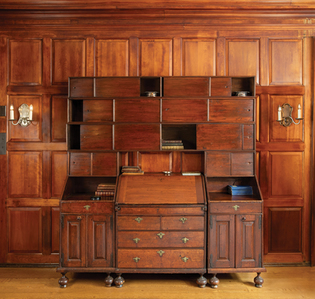
Desk of Jonathan Edwards (1703–1758), Class of 1720, ’23MA
Artwork: circa 1700–1730, maker unknown
Jonathan Edwards College, Head of College House
While exploring JE, I saw several portraits of the college’s namesake and members of his extended family, as expected. But upon entering the head of college’s dining room (invited, of course), an impressive work of early eighteenth-century cabinetry immediately caught my eye. Standing over six feet tall and nearly as wide, it features a slope-front desk, adjoining cabinets, overhead bookshelves with sliding doors, and shiny brass drawer pulls. A helpful sign informs visitors that this was an “antique desk belonging to Jonathan Edwards” and admonishes “Please do not place any items on the desk.” Saying a silent “thank you” to whoever was responsible for this sign, I was off to investigate the origin of this desk.
Jonathan Edwards, a Congregationalist preacher and theologian, was an influential figure in the early history of Yale, yet we don’t know for certain that this desk belonged to him. A 1934 article in the Bulletin of the Associates in Fine Arts at Yale University describes an incident three years earlier: the Divinity School building was scheduled for demolition, and an antique desk, found in the basement, was in need of a home. Divinity students and faculty had always referred to it as the Jonathan Edwards Desk, but no one could quite remember who said it first. It’s true that the central component of the desk is contemporary to Edwards’s early life and career. (The shelves were a later addition.) And logically, Edwards would require something substantial to organize his many books and writings. In any event, the desk was relocated to the newly constructed Jonathan Edwards College.
In researching the provenance of art and artifacts, it’s necessary to consider primary source documentation as well as oral history and tradition.
 loading
loading